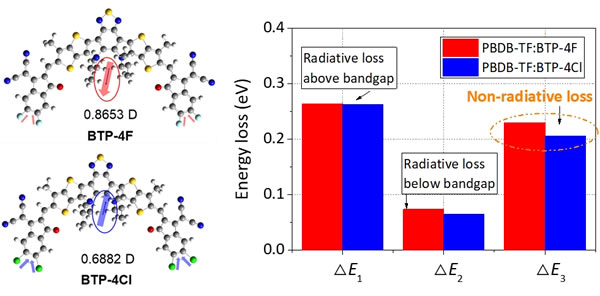Compared with traditional inorganic solar cells, a new generation of organic solar cells (OPV) has unique advantages and application prospects. Improving its photoelectric conversion efficiency is one of the main research contents in this field. In recent years, thanks to the application of new photovoltaic materials and the optimization of device fabrication technology, the efficiency of OPV has developed rapidly, and has exceeded 15%. At present, the main factor limiting the further improvement of OPV efficiency is its large non-radiative energy loss in the photoelectric conversion process.
With the support of the Chinese Academy of Sciences and the National Natural Science Foundation of China, Hou Jianhui, a researcher in the Polymer Physics and Chemistry Laboratory, Institute of Chemistry, Chinese Academy of Sciences, has long been committed to improving the efficiency of battery devices through molecular design of organic photovoltaic materials. Research. In the previous work (J. Am. Chem. Soc. 2017, 139, 7148; Angew. Chem. Int. Ed. 2017, 56, 3045; Adv. Mater. 2017, 29. 1703080; Adv. Mater. 2018, 30, e1800613), the researchers systematically studied the application of halogen modification methods in molecular design optimization, prepared a series of excellent organic photovoltaic materials, and achieved continuous improvement in efficiency in battery devices.
Recently, researchers have prepared a chlorine-modified electron acceptor material BTP-4Cl, which has achieved very outstanding photovoltaic efficiency in the battery: the small area battery efficiency of 0.09 cm2 is as high as 16.5%, and the battery efficiency of 1 cm2 remains at 15.3%. These results are the best reported in the current field. The research results show that, compared with the fluorinated material (BTP-4F) battery, the performance improvement of the BTP-4Cl battery is mainly due to its lower non-radiative energy loss. This work proves that the design of photovoltaic material molecules is an effective way to reduce non-radiative energy loss, and is of great significance for the further improvement of OPV efficiency. In this work, the researchers and the team of Wei Zhixiang, a researcher of the National Nanoscience Center, and the Gao Feng team of professors at Linköping University in Sweden have carried out close cooperation in morphology and mechanism. The relevant work was published in the recent "Nature. Communications" . 2019, 10, 2515).

Figure: Energy loss of battery devices based on different halogenated acceptor materials
It is made from high grade Low Carbon steel iron wire, heavy zinc coated wire, PVC coated wire though twisting and braiding by machine. as well as galfan coated units. Galfan is a high performance galvanising process using a zinc/aluminium/mischmetal alloy coating. This offers significantly greater protection than traditional zinc galvanizing. Where the product is exposed to water courses or a saline environment, we strongly recommends a polymer coated galvanized unit for improved design life.
Pvc Gabion,Pvc Coated Gabions,Gabions Mesh Galvanised Wire,Pvc Coated Gabion Mesh Box
Shenzhou City Hongda Hardware Products Co.,Ltd , https://www.hdgabion.com